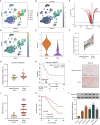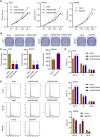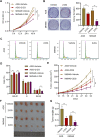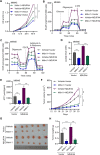m6A RNA methylation-mediated NDUFA4 promotes cell proliferation and metabolism in gastric cancer
- PMID: 35977935
- PMCID: PMC9385701
- DOI: 10.1038/s41419-022-05132-w
m6A RNA methylation-mediated NDUFA4 promotes cell proliferation and metabolism in gastric cancer
Abstract
Gastric cancer (GC) is a malignancy with poor prognosis. NDUFA4 is reported to correlate with the progression of GC. However, its underlying mechanism in GC is unknown. Our study was to reveal the pathogenic mechanism of NDUFA4 in GC. NDUFA4 expression was explored in single-cell and bulk RNA-seq data as well as GC tissue microarray. Mitochondrial respiration and glycolysis were estimated by oxygen consumption rate and extracellular acidification rate, respectively. The interaction between NDUFA4 and METTL3 was validated by RNA immunoprecipitation. Flow cytometry was used to estimate cell cycle, apoptosis and mitochondrial activities. NDUFA4 was highly expressed in GC and its high expression indicated a poor prognosis. The knockdown of NDUFA4 could reduce cell proliferation and inhibit tumor growth. Meanwhile, NDUFA4 could promote glycolytic and oxidative metabolism in GC cells, whereas the inhibition of glycolysis suppressed the proliferation and tumor growth of GC. Besides, NDUFA4 inhibited ROS level and promoted MMP level in GC cells, whereas the inhibition of mitochondrial fission could reverse NDUFA4-induced glycolytic and oxidative metabolism and tumor growth of GC. Additionally, METTL3 could increase the m6A level of NDUFA4 mRNA via the m6A reader IGF2BP1 to promote NDUFA4 expression in GC cells. Our study revealed that NDUFA4 was increased by m6A methylation and could promote GC development via enhancing cell glycolysis and mitochondrial fission. NDUFA4 was a potential target for GC treatment.
© 2022. The Author(s).
Conflict of interest statement
The authors declare no competing interests.
Figures








Similar articles
-
Dysregulated N6-methyladenosine methylation writer METTL3 contributes to the proliferation and migration of gastric cancer.J Cell Physiol. 2020 Jan;235(1):548-562. doi: 10.1002/jcp.28994. Epub 2019 Jun 24. J Cell Physiol. 2020. PMID: 31232471
-
The m6A Methyltransferase METTL3-Mediated N6-Methyladenosine Modification of DEK mRNA to Promote Gastric Cancer Cell Growth and Metastasis.Int J Mol Sci. 2022 Jun 9;23(12):6451. doi: 10.3390/ijms23126451. Int J Mol Sci. 2022. PMID: 35742899 Free PMC article.
-
Long non-coding RNA MIF-AS1 promotes gastric cancer cell proliferation and reduces apoptosis to upregulate NDUFA4.Cancer Sci. 2018 Dec;109(12):3714-3725. doi: 10.1111/cas.13801. Epub 2018 Oct 31. Cancer Sci. 2018. PMID: 30238562 Free PMC article.
-
Exploring m6A modifications in gastric cancer: from molecular mechanisms to clinical applications.Eur J Med Res. 2025 Feb 12;30(1):98. doi: 10.1186/s40001-025-02353-5. Eur J Med Res. 2025. PMID: 39940056 Free PMC article. Review.
-
The role of RNA m6A methylation in lipid metabolism.Front Endocrinol (Lausanne). 2022 Sep 8;13:866116. doi: 10.3389/fendo.2022.866116. eCollection 2022. Front Endocrinol (Lausanne). 2022. PMID: 36157445 Free PMC article. Review.
Cited by
-
WTAP-mediated m6A modification of lncRNA Snhg1 improves myocardial ischemia-reperfusion injury via miR-361-5p/OPA1-dependent mitochondrial fusion.J Transl Med. 2024 May 25;22(1):499. doi: 10.1186/s12967-024-05330-4. J Transl Med. 2024. PMID: 38796415 Free PMC article.
-
N6-methyladenosine (m6A) writer KIAA1429 accelerates gastric cancer oxaliplatin chemoresistance by targeting FOXM1.J Cancer Res Clin Oncol. 2023 Jul;149(8):5037-5045. doi: 10.1007/s00432-022-04426-y. Epub 2022 Nov 3. J Cancer Res Clin Oncol. 2023. PMID: 36326914 Free PMC article.
-
METTL5 promotes gastric cancer progression via sphingomyelin metabolism.World J Gastrointest Oncol. 2024 May 15;16(5):1925-1946. doi: 10.4251/wjgo.v16.i5.1925. World J Gastrointest Oncol. 2024. PMID: 38764837 Free PMC article.
-
Mitochondria: a new intervention target for tumor invasion and metastasis.Mol Med. 2024 Aug 23;30(1):129. doi: 10.1186/s10020-024-00899-4. Mol Med. 2024. PMID: 39179991 Free PMC article. Review.
-
Oviductal extracellular vesicles from women with endometriosis impair embryo development.Front Endocrinol (Lausanne). 2023 Jun 20;14:1171778. doi: 10.3389/fendo.2023.1171778. eCollection 2023. Front Endocrinol (Lausanne). 2023. PMID: 37409222 Free PMC article.
References
-
- Allemani C, Weir HK, Carreira H, Harewood R, Spika D, Wang XS, et al. Global surveillance of cancer survival 1995-2009: analysis of individual data for 25,676,887 patients from 279 population-based registries in 67 countries (CONCORD-2) Lancet (Lond, Engl) 2015;385:977–1010. doi: 10.1016/S0140-6736(14)62038-9. - DOI - PMC - PubMed
Publication types
MeSH terms
Substances
LinkOut - more resources
Full Text Sources
Medical
Molecular Biology Databases
Miscellaneous

